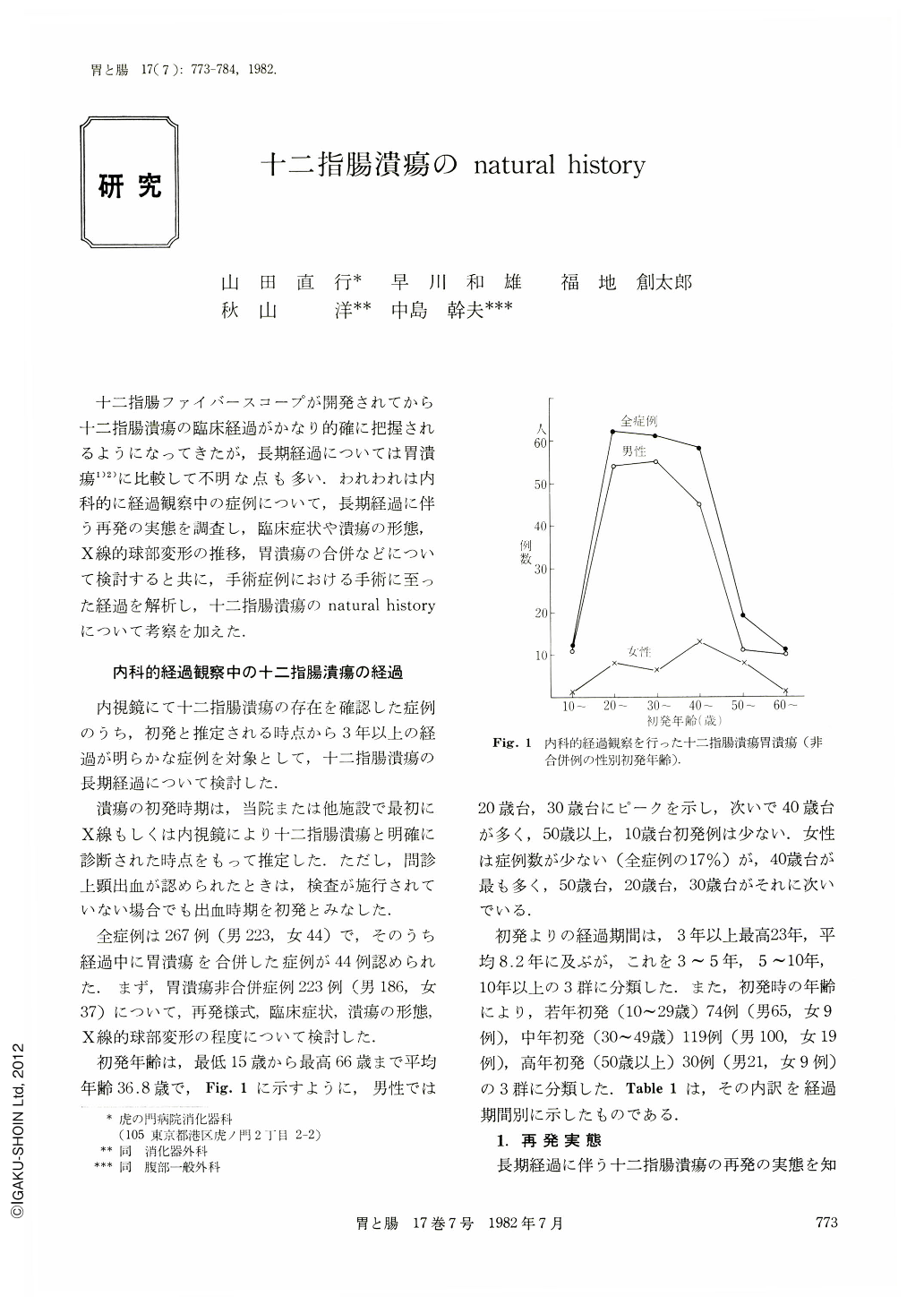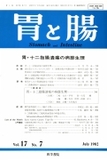Japanese
English
- 有料閲覧
- Abstract 文献概要
- 1ページ目 Look Inside
十二指腸ファイバースコープが開発されてから十二指腸潰瘍の臨床経過がかなり的確に把握されるようになってきたが,長期経過については胃潰瘍1)2)に比較して不明な点も多い.われわれは内科的に経過観察中の症例について,長期経過に伴う再発の実態を調査し,臨床症状や潰瘍の形態,X線的球部変形の推移,胃潰瘍の合併などについて検討すると共に,手術症例における手術に至った経過を解析し,十二指腸潰瘍のnatural historyについて考察を加えた.
内科的経過観察中の十二指腸潰蕩の経過
内視鏡にて十二指腸潰瘍の存在を確認した症例のうち,初発と推定される時点から3年以上の経過が明らかな症例を対象として,十二指腸潰瘍の長期経過について検討した.
To clarify a natural history of duodenal ulcer, we studied a long-term prognosis of medically followed as well as surgically operated cases of duodenal ulcer.
The former included 267 cases of duodenal ulcer which had more than three year-prognosis from its initial occurrence and the latter included 195 cases of duodenal ulcer which were operated at our institution for over the last 20 years and their process to the operation was investigated.
The results obtained were as follows.
(1) Analyzing the prognosis of 155 cases of endoscopically confirmed healed ulcer with scar, it was noted that their recurrence rate increased according to the prolongation of their follow-up term, and 84% of them had recurrence within five years.
(2) Studying the real state of recurrence of the 173 cases which had more than five year-prognosis from the initial occurrence, it was found that juvenile onset group, which had initial occurrence at less than 30 years old, had periodic frequent recurrence than middle aged or old aged onset groups which showed tendency of less frequent recurrence.
(3) Abdominal pain was the most frequent clinical symptom associated with their recurrence and 21% of cases had frequent G. I. bleeding almost always associated with their recurrence. Furthermore 38% of them had G. I. bleeding at least once in the past. Regarding age of initial onset, juvenile onset group had more frequent G. I. bleeding than middle aged or old aged onset groups and 57% of early onset group had past history of G. I. bleeding which was signifi-cantly higher than other groups.
(4) Regarding relationship between ulcer morphology and its recurrence, multiple and linear ulcers had more frequent recurrence rate than solitary ulcer.
(5) Radiologic study showed the degree of deformed bulb became more prominant according to the following orders; Namely solitary, multiple and linear ulcer. Both solitary and multiple ulcer tend to have more severe deformity by the prolongation of ill period, but linear ulcer had marked deformity from the early stage of the illness.
(6) Among the 267 cases of duodenal ulcer, 44 cases (16.5%) developed gastric ulcer during their followup and its most frequent location was at the angulus, then at the pyloric region and less frequently at the gastric body. Three cases were found to have gastric ulcers at both angulus and gastric body, and one of them had open type by Congo-red method, and repeated study was carried out seven years later but showed no significant change of atrophic pattern of fundic mucosa.
(7) In duodenal ulcer, regardless of patient's age, most cases showed closed type by Congo-red method and no atrophy was observed at the fundic mucosa. Considering the prognosis of the above mentioned cases which were accompanied by gastric ulcer, these cases seem to have no progressive atrophy of the fundic mucosa by age.
(8) The reasons why the duodenal ulcer had operation were as follows; Most frequent reason was stenosis, then bleeding, unresponsive ulcer or frequent recurrence and finally perforation. Three major complications were seen in 77% of them.
(9) Gastric out-let obstruction was most frequently seen at the linear type and most of them had relati-vely prolonged ill-period but few cases developed the gastric out-let obstruction as early as less than one year from their initial occurrence.
(10) It should be noted that most of them, except for one perforated case, were solitary ulcers at the anterior wall of the duodenal bulb, and their ill-period was short, and considered to be initial occurrence.

Copyright © 1982, Igaku-Shoin Ltd. All rights reserved.


